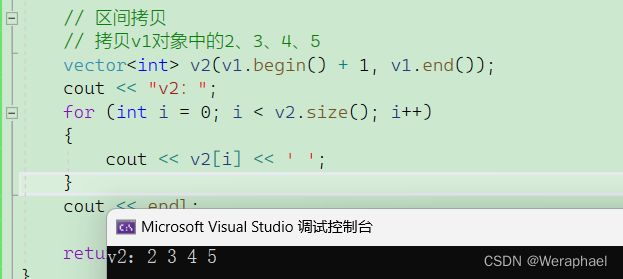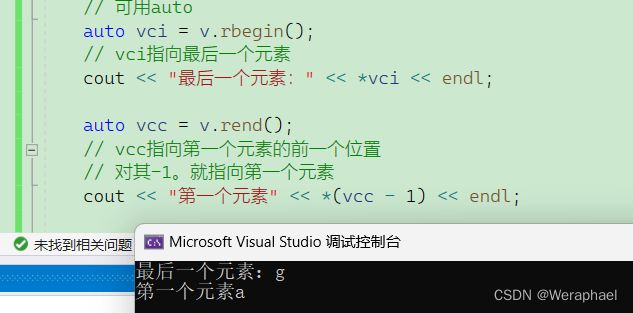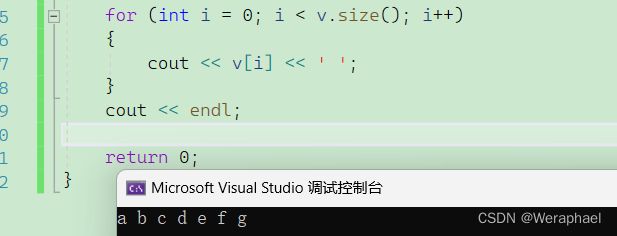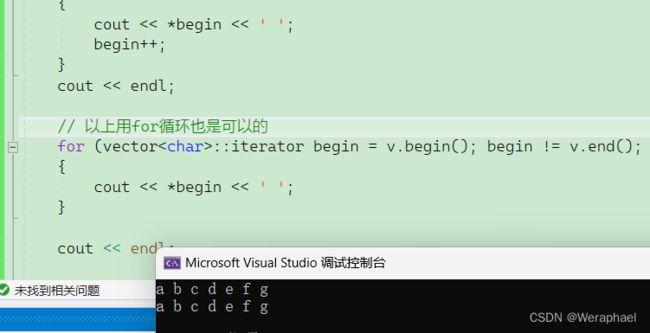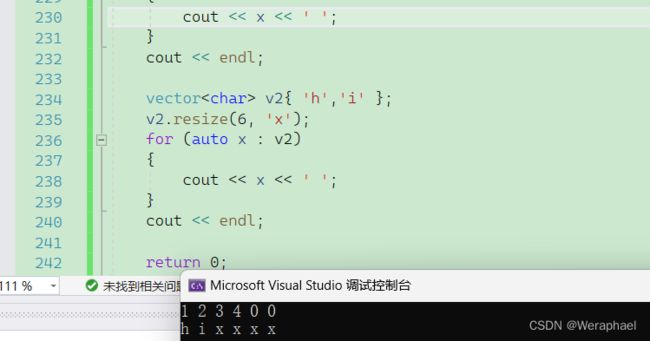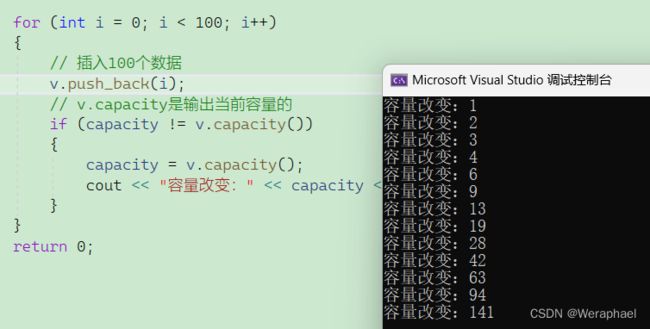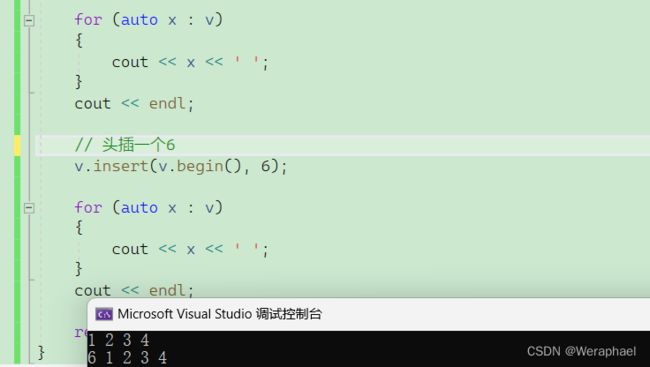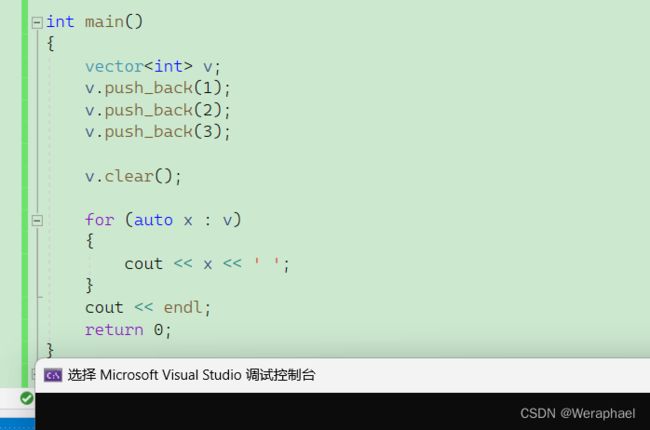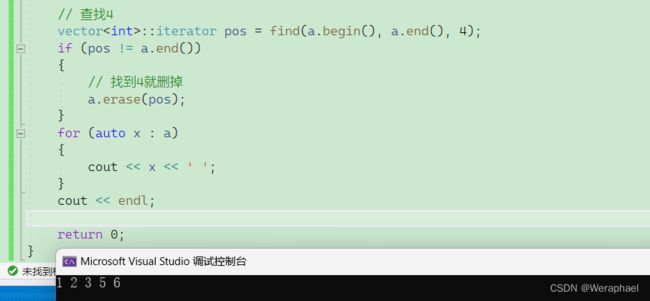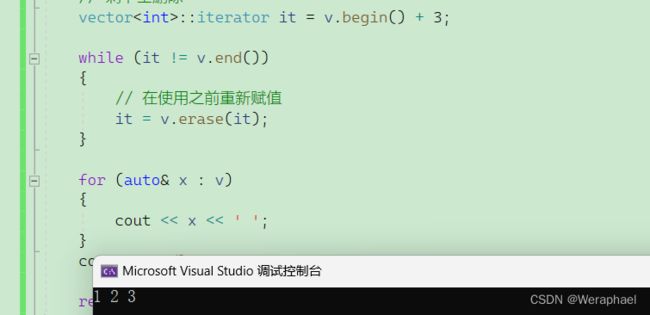【C++初阶】vector容器
![]()
个人主页:@Weraphael
✍作者简介:目前学习C++和算法
✈️专栏:C++航路
希望大家多多支持,咱一起进步!
如果文章对你有帮助的话
欢迎 评论 点赞 收藏 加关注✨
目录
- 一、什么是vector
- 二、vector初始化
-
-
- 2.1 默认构造函数(常见)
- 2.2 构造函数将n个元素拷贝给本身
- 2.3 拷贝构造函数(常见)
- 2.4 区间拷贝
- 2.5 数组方式
-
- 三、迭代器的使用
-
-
- 3.1 begin + end(常见)
- 3.2 rbegin + rend
-
- 四、遍历
-
-
- 4.1 operator[]
- 4.2 迭代器遍历
- 4.3 范围for
-
- 五、空间增长问题
-
-
- 5.1 size
- 5.2 empty
- 5.3 resize
- 5.4 reserve
- 5.5 swap
-
- 六、vector的插入与删除
-
-
- 6.1 push_back - 尾插
- 6.2 pop_back - 尾删
- 6.3 insert - 插入
- 6.4 erase - 删除pos位置的数据
- 6.5 clear - 清空所有数据
-
- 七、几个常用算法
-
-
- 7.1 sort - 排序
- 7.2 reverse
- 7.3 find
-
- 八、迭代器失效问题
-
-
- 8.1 什么是迭代器失效
- 8.2 为什么string不存在迭代器失效问题
- 8.3 几个常见的迭代器失效样例
- 8.4 如何解决迭代器失效问题
-
一、什么是vector
vector容器和数组非常相似,与普通数组的区别:数组是静态空间,而vector可以动态扩展。- 动态扩展并不是在原空间之后续接新空间,而是找更大的内存空间,然后将原数据拷贝新空间,释放原空间。
- 使用
vector容器需要包含头文件:#include vector可以存储多种不同的数据类型,是因为它是一个模板容器

通过使用模板参数,我们可以在vector中指定要存储的数据类型,例如:
vector<int> vi // 整型容器
vector<char> vc // 字符型容器
vector<double> vd // 浮点型容器
vector<string> vs // string类型容器
vector<vector<int>> // 本质是二维数组
// 等等...
类模板实例化与普通类的实例化不同,类模板实例化需要在类模板名字后跟<>,然后将实例化的类型放在<>中即可,而普通类的类名就是类型。
注意:需要注意数据类型的统一性。例如,如果创建了一个存储整数的vector,就应该只向其中存储整数类型的数据,否则可能会出现类型错误或数据损坏的问题。
二、vector初始化
2.1 默认构造函数(常见)
#include 默认构造的对象,size和capacity都为0。
2.2 构造函数将n个元素拷贝给本身
【函数原型】
vector<T> v(n,elem);
【代码示例】
#include 【输出结果】
2.3 拷贝构造函数(常见)
【函数原型】
vector (const vector& x);
【代码示例】
#include 【输出结果】
2.4 区间拷贝
【函数原型】
vector(v.begin(),v.end());
【代码示例】
#include 【输出结果】
2.5 数组方式
#include 【输出结果】
三、迭代器的使用
3.1 begin + end(常见)
大家可以认为迭代器是指针。begin指向第一个数据的位置,end指向最后一个数据的下一个位置
【代码示例】
#include 【输出结果】
3.2 rbegin + rend
【代码示例】
#include ::iterator 如果认为太长
// 可用auto
auto vci = v.rbegin();
// vci指向最后一个元素
cout << "最后一个元素:" << *vci << endl;
auto vcc = v.rend();
// vcc指向第一个元素的前一个位置
// 对其-1。就指向第一个元素
cout << "第一个元素" << *(vcc - 1) << endl;
return 0;
}
【输出结果】
四、遍历
4.1 operator[]
vector底层重载了下标访问操作符[],因此可以像数组一样变量
#include 【输出结果】
4.2 迭代器遍历
#include 【输出结果】
4.3 范围for
在
string类时,我们讲过 范围for的底层是迭代器。
#include 【输出结果】
五、空间增长问题
5.1 size
功能:获取数据的有效个数
#include 【输出结果】
5.2 empty
功能:判断容器是否为空。如果为空返回1,否则返回0
#include 【输出结果】
5.3 resize
【函数原型1】
resize(int num);
功能:重新指定容器的长度为
num
情况1:若有效数据size > num,则会保留前num个,剩下的删除
#include 【程序结果】
【函数原型2】
resize(int num, elem);
情况2:若num > size,则会增加有效长度。如果不指定第二个参数,默认增加的内容是0
#include 【输出结果】
5.4 reserve
功能:改变
vector容器的容量。一般都是扩容。
#include 【输出结果】
通过以上代码我们发现:vs下的容量是按1.5倍增长的g++是按2倍增长的。
然后我们再把以上代码拿到Linux环境下测试:
我们发现:Linux下使用的vector是按照2倍方式扩容。
因此,如果已经确定vector中要存储元素大概个数,可以提前将空间设置足够就可以避免边插入边扩容导致效率低下的问题了。
#include 【输出结果】
或者还能这样开空间:
5.5 swap
【函数原型】
swap(vec); // 将vec与本身的元素互换
【代码示例】
#include 【输出结果】
通过以上发现:swap不仅可以交换容器内容,同时还达到实用的收缩内存效果
六、vector的插入与删除
6.1 push_back - 尾插
#include 【输出结果】
6.2 pop_back - 尾删
#include 【输出结果】
6.3 insert - 插入
【函数原型1】
iterator insert (iterator position, const value_type& val);
注意:insert是要配合迭代器使用的!
#include 【输出结果】
【函数原型2】
void insert (iterator position, size_type n, const value_type& val);
【代码样例】
#include 【输出结果】
6.4 erase - 删除pos位置的数据
【函数原型1】
erase(const iterator pos);
注意:erase也是要配合迭代器使用的
#include 【输出结果】
【函数原型2】
erase(const iterator start,const iterator end)
功能:删除某个区间的数据
【代码示例】
#include 【输出结果】
除了以上方式可以清空数据,clear同样也行
6.5 clear - 清空所有数据
#include 【输出结果】
七、几个常用算法
注意:使用库里的算法需要加上头文件
#include
7.1 sort - 排序
#include 【输出结果】
7.2 reverse
#include 【输出结果】
7.3 find
注意:vector是没有提供find接口的。而我们知道vector是一个类似于数组的容器,因此如果想找一个数据,直接遍历即可。但是算法库提供了find
#include 【输出结果】
八、迭代器失效问题
8.1 什么是迭代器失效
迭代器失效实际就是迭代器底层对应指针所指向的空间被销毁了,而使用一块已经被释放的空间,造成的后果是程序崩溃。即如果继续使用已经失效的迭代器,程序可能会崩溃。
8.2 为什么string不存在迭代器失效问题
string是一个特殊的容器,它是由字符组成的连续序列,类似于C语言的字符串。string类会动态地管理内部存储区域,确保足够的容量容纳字符串。当我们向string中插入或删除字符时,并不会导致整个字符串被复制到新的内存位置,因此迭代器不会失效。
对比vector,它是一个动态数组,它使用连续的内存存储元素。当我们向vector中插入元素时,如果导致当前内存不足以容纳所有元素,vector会重新分配更大的内存空间,并将所有元素复制到新的内存中。这样一来,原来指向旧内存中的元素的迭代器就会失效,因为它们指向的位置已经改变了。
8.3 几个常见的迭代器失效样例
当涉及到插入或删除操作时,我们需要注意vector迭代器的失效问题
- 会引起其底层空间改变的操作,都有可能是迭代器失效,比如:
resize、reserve、insert、push_back等
#include 以上操作可能会导致vector扩容,扩容就会导致旧空间被释放掉,而返回的迭代器是指向被释放的空间,如果再对迭代器进行使用,会引起代码崩溃。
- 指定位置元素的删除操作
#include 【输出结果】
理论上删除了4,*pos应该是5,可是为什么没有打印出来呢?
我们可以通过调试来观察:
当我再按F10,发现pos的地址变了:
理论上删除4后,5应该占据4的空间,然而地址却变了。因此导致了迭代器失效了。
那如果是删除最后一个数据,那么结果更加明显:
8.4 如何解决迭代器失效问题
在使用前,对迭代器重新赋值即可。
#include 【输出结果】



